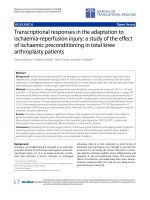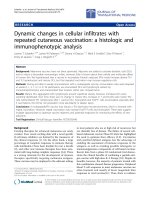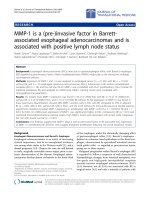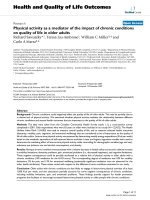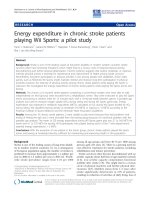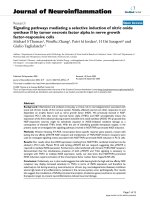báo cáo hóa học: " Health-state utilities in a prisoner population: a cross-sectional survey" pdf
Bạn đang xem bản rút gọn của tài liệu. Xem và tải ngay bản đầy đủ của tài liệu tại đây (206.48 KB, 7 trang )
BioMed Central
Page 1 of 7
(page number not for citation purposes)
Health and Quality of Life Outcomes
Open Access
Research
Health-state utilities in a prisoner population: a cross-sectional
survey
Christopher AKY Chong*
1,2
, Sicong Li
3
, Geoffrey C Nguyen
4,5
,
Andrew Sutton
6
, Michael H Levy
7
, Tony Butler
7,8
, Murray D Krahn
2,9
and
Hla-Hla Thein
10
Address:
1
Section of General Internal Medicine, Lakeridge Health Oshawa, Canada,
2
Faculty of Health Sciences, Queen's University, Ontario,
Canada,
3
Faculty of Pharmacy, University of Toronto, Toronto, Ontario, Canada,
4
Mount Sinai Hospital Division of Gastroenterology, University
of Toronto, Toronto, Ontario, Canada,
5
Johns Hopkins School of Medicine, Baltimore, Maryland, USA,
6
Ecology and Epidemiology Group,
Department of Biological Sciences, University of Warwick, Warwick, UK,
7
Centre for Health Research in Criminal Justice, Sydney, Australia,
8
School of Public Health and Community Medicine, The University of New South Wales, Sydney, Australia,
9
Toronto Health Economics and
Technology Assessment Collaborative, Department of Medicine Toronto, Ontario, Canada and
10
National Centre in HIV Epidemiology and
Clinical Research, The University of New South Wales, Sydney, Australia
Email: Christopher AKY Chong* - ; Sicong Li - ; Geoffrey C Nguyen - ;
Andrew Sutton - ; Michael H Levy - ; Tony Butler - ;
Murray D Krahn - ; Hla-Hla Thein -
* Corresponding author
Abstract
Background: Health-state utilities for prisoners have not been described.
Methods: We used data from a 1996 cross-sectional survey of Australian prisoners (n = 734).
Respondent-level SF-36 data was transformed into utility scores by both the SF-6D and Nichol's
method. Socio-demographic and clinical predictors of SF-6D utility were assessed in univariate
analyses and a multivariate general linear model.
Results: The overall mean SF-6D utility was 0.725 (SD 0.119). When subdivided by various medical
conditions, prisoner SF-6D utilities ranged from 0.620 for angina to 0.764 for those with none/mild
depressive symptoms. Utilities derived by the Nichol's method were higher than SF-6D scores,
often by more than 0.1. In multivariate analysis, significant independent predictors of worse utility
included female gender, increasing age, increasing number of comorbidities and more severe
depressive symptoms.
Conclusion: The utilities presented may prove useful for future economic and decision models
evaluating prison-based health programs.
Background
Prisoners represent an understudied population in health
care research although they have a disproportionately
high prevalence of many illnesses. For example, the prev-
alence of a wide-range of psychiatric disorders is easily
more than double than that found in the community [1].
About 2% of the U.S. general population test positive for
the hepatitis C antibody, compared to 12 to 64% of pris-
oners [2]. In particular, few investigations have explored
the health-related quality of life (HRQL) of prisoners.
Published: 28 August 2009
Health and Quality of Life Outcomes 2009, 7:78 doi:10.1186/1477-7525-7-78
Received: 14 April 2009
Accepted: 28 August 2009
This article is available from: />© 2009 Chong et al; licensee BioMed Central Ltd.
This is an Open Access article distributed under the terms of the Creative Commons Attribution License ( />),
which permits unrestricted use, distribution, and reproduction in any medium, provided the original work is properly cited.
Health and Quality of Life Outcomes 2009, 7:78 />Page 2 of 7
(page number not for citation purposes)
Understanding inmate HRQL is essential to developing
effective prison health programs and policies.
To the best of our knowledge, HRQL measurements in the
form of utilities have not been obtained in prisoners. A
utility is a preference-based, global measurement of over-
all health on a scale of 0 to 1, and is the most widely used
method for evaluating HRQL in economic and decision
analyses [3]. To date researchers have been limited to
using utilities obtained from non-inmate populations
[4,5]. However, the social, demographic, economic and
health status of prisoners is clearly different from other
groups [1,2]. Thus, specifically using inmate-based utili-
ties could improve the validity and quality of economic
and decision analyses that evaluate prison health pro-
grams.
The primary purpose of our study was to derive inmate-
based utilities for use in future economic and decision
models. Secondary objectives were to explore how socio-
demographics and comorbidity affect prisoner HRQL and
to compare different methods for deriving utilities.
Methods
Survey
Detailed methods of the survey have been published else-
where [6]. Briefly, ethics approval was obtained from the
Justice Health Human Ethics and Research Committee
and the New South Wales (NSW) Department of Correc-
tive Services Ethics Committee. In 1996, NSW Justice
Health surveyed a cross-sectional random sample of pris-
oners from 27 male and two female correctional services,
stratified for age, gender and indigenous origin. Partici-
pants were randomly chosen from a list of all inmates at
each prison and those selected provided written consent;
those that refused were replaced by inmates on a reserve
list. Participants were compensated with $A 10.
Study nurses conducted extensive face-to-face structured
interviews and participants completed various health
questionnaires. Information collected included: 1) stand-
ard socio-demographic characteristics. 2) Comorbidities,
gathered as self-reported health conditions. The survey
also assessed whether prescribed medications for certain
chronic health conditions had been used in the preceding
two weeks, allowing us to further confirm some self-
reported diagnoses. 3) Hepatitis C viral infection (HCV)
status. The original purpose of this survey included assess-
ing the prevalence of bloodborne infections, and HCV
antibody and viral polymerase chain reaction (PCR) sta-
tus were obtained through standard laboratory testing [6].
4) Beck Depression Inventory (BDI). The BDI is a well-
established 21-item questionnaire that assesses depres-
sion severity in the preceding week, with higher scores
indicating more severe symptoms. The scores can then be
divided into none, mild, moderate or severe symptom
groups [7]. 5) World Health Organization Alcohol Use
Disorder level, which classifies alcohol consumption in
safe, harmful or hazardous categories [8]. 6) Short-Form
36 (SF-36). The SF-36 is a very widely used non-preference
based general health survey that measures HRQL during
the previous four weeks over eight domains [9].
Of the 789 patients in the original study, 55 did not com-
plete the SF-36. Because the main purpose of this study
was to derive utilities and the SF-36 was necessary to do so
(see below), these 55 were excluded from the analysis for
a final sample size of 734. The purpose of the original sur-
vey was to detect a range of health conditions from the
NSW prisoner population and the sample size was thus
chosen for that specific aim. The primary objective of this
study is to provide an estimate of mean prisoner-based
utilities; assuming an SF-6D standard deviation of 0.147
[10] and an acceptable error of 0.05, the needed sample
size would be 33 [11], which is comparable to the usual
recommendation of 30 to 60 subjects for standard gamble
utility studies [12].
Deriving utilities
Several methods exist for transforming SF-36 scores into
utilities. These techniques attempt to translate the non-
preference-based SF-36 health description into an
accepted preference-based utility measurement. Existing
techniques allow translating the SF-36 description into
the Visual Analogue Scale, Health Utilities Index, Quality
of Well Being Scores or Standard Gamble, all of which are
distinct forms of measuring utilities. We selected what we
felt were the two most robust methods, the Nichol
method [13] and the Brazier SF-6D method [14]. The dif-
ferent techniques are not meant to be averaged together.
In the Nichol method, the eight SF-36 domain scores are
first transformed into norm-based scores that have been
standardized to the 1998 general United States (US) pop-
ulation for a mean of 50 and a standard deviation of 10.
A regression equation developed from a sample of 6921
subjects is then applied to these eight scores to convert
them into a Health Utilities Index II (HUI2) utility. The
HUI2 is a multi-attribute health state classification system
that defines 24 000 hypothetical unique health states and
assigns a utility to each one using preference scores
derived from a survey of the general population [15]. The
utilities are based on the standard gamble, which is argu-
ably the utility scaling method with the strongest theoret-
ical foundation [3]. The Nichol translation of SF-36 scores
predicts 50.5% of the variance in HUI2 utilities. The range
of possible utilities using this method is -0.03 to 1.00.
Brazier's SF-6D method represents a more exact method
of transforming SF-36 data into utilities. Respondent-level
Health and Quality of Life Outcomes 2009, 7:78 />Page 3 of 7
(page number not for citation purposes)
data from the SF-36 questions are first explicitly restruc-
tured into six health domains which describe 18 000
health states. Using the standard gamble, 611 members of
the United Kingdom (UK) general population valued a
249 subset of these states, and a model was then devel-
oped to define utilities for the full set. Of existing methods
for converting SF-36 data into utilities, this technique may
be the most robust as it uses respondent-level data to
clearly define unique health states which have been
directly valued by a general population. Like the HUI2,
the SF-6D represents community derived preferences for
health outcomes. The range of possible utilities based on
this model is 0.30 to 1.00.
Analysis
To compare the distribution of categorical variables, con-
tingency chi square analysis was used. When appropriate,
t-tests or one-way analysis of variance with post-hoc Tukey
tests were used to compare means of continuous varia-
bles. Pearson and Spearman tests were used to examine
correlations between continuous variables. Statistical sig-
nificance was defined at p < 0.05.
To assess predictors of utilities, all the socio-demographic
and clinical characteristics were first assessed for signifi-
cance in univariate analysis. All characteristics were then
correlated with one another to assess for collinearity. Most
clinical factors were found to be collinear (e.g. subjects
reporting one medical condition were more likely to also
report another medical condition), making it difficult to
enter them all as independent variables. We thus col-
lapsed all the medical conditions into a single variable of
comorbidity count. We considered depression (BDI score)
separately from other comorbid illnesses, as we were par-
ticularly interested in the effect of mental health. Variables
that were significant at p < 0.10 were then entered as cov-
ariates in a forward step-wise general linear regression
model that included the forced variables of gender and
age. Variables that continued to be significant at a two-
sided level of p < 0.10 were kept as main effects. Two-way
interactions for the remaining variables were then
assessed for significance.
All analyses were performed with SPSS version 16.0.
Results
Socio-demographic characteristics
Table 1 outlines the socio-demographic features of the
734 participants in the study. The prisoner population
was predominantly young and male, with low education
and pre-incarceration employment levels. Most had spent
less than one year in prison. In the 55 subjects who were
excluded because they did not complete the SF-36, there
was a higher proportion of females (29.1% vs. 15.8%, p =
0.011) and Aboriginal people (41.8% vs. 28.9%, p =
0.043) than in those who did complete the SF-36.
Utilities
The SF-6D and Nichol utilities for the entire sample strat-
ified by various conditions are presented in Table 2. SF-6D
utilities range from 0.620 for those reporting angina and
using cardiac medication to 0.764 for those scoring none/
mild symptoms on the BDI. The Nichol estimated utilities
are consistently higher than the SF-6D; the average paired
mean difference is 0.122 (SD 0.059, p < 0.001). The two
methods, are, however, highly correlated with a Spearman
correlation of 0.898 (p < 0.001).
In univariate analysis, prisoners had significantly lower
SF-6D utilities with the following conditions than with-
out the conditions (p ≤ 0.005 for all): angina (delta utility
[Δ] = -0.090), arthritis (Δ = -0.070), asthma (Δ = -0.048),
back problems (Δ = -0.078), worse BDI score (Δ = -0.071
for moderate vs. none/mild; Δ = -0.139 for severe vs.
none/mild), cholelithiasis (Δ = -0.093), epilepsy (Δ = -
0.057), hemorrhoids (Δ = -0.069), hypertension (Δ = -
0.060), prison methadone program use (Δ = -0.043), pep-
tic ulcer disease (Δ = -0.066), prostate condition (Δ = -
0.069), and psychiatric medication use (Δ = -0.090). Self-
reporters of hepatitis B had lower scores approaching sta-
tistical significance (Δ = -0.024, p = 0.074). Harmful or
hazardous alcohol consumption was not associated with
significantly different scores (p = 0.412). The remaining
conditions that did not reach statistical significance (dia-
betes Δ = -0.025, human immunodeficiency virus [HIV] Δ
= -0.059, and kidney condition Δ = -0.004) had 25 or
fewer participants reporting the condition.
Table 1: Socio-demographic characteristics of prisoner
respondents (total n = 734)
Characteristic n (percentage)
Male 618 (84.2)
Age (years)
18 - 24 242 (33.0)
25 - 39 278 (37.9)
≥ 40 214 (29.2)
Aboriginal 212 (28.9)
Born in Australia 595 (81.1)
Time in jail (years)
≤ 1 403 (54.9)
> 1 to ≤ 5 253 (34.5)
> 5 78 (10.6)
Marital status
single 273 (37.2)
married/regular partner 394 (53.7)
Sexual identity
Heterosexual 640 (87.2)
Working before entering prison 314 (42.8)
Educational status
no formal qualification 361 (49.2)
Accommodation before entering prison
renting 401 (54.6)
live with family/own home 255 (34.7)
Health and Quality of Life Outcomes 2009, 7:78 />Page 4 of 7
(page number not for citation purposes)
Table 2: SF-6D and Nichol utilities for prisoner respondents by medical conditions.
n (percentage) mean SF-6D utility (SD) mean Nichol utility (SD)
Total 734 (100) 0.725 (0.119) 0.846 (0.133)
Alcohol use
harmful
†
282 (38.4) 0.732 (0.115) 0.854 (0.129)
Angina/chest pain
self-report 81 (11.0) 0.644 (0.131) 0.742 (0.161)
self-report & med* 17 (2.3) 0.620 (0.169) 0.687 (0.206)
Arthritis
self-report 120 (16.3) 0.666 (0.116) 0.772 (0.137)
Asthma
self-report 153 (20.8) 0.687 (0.122) 0.796 (0.142)
self-report & med* 69 (9.4) 0.656 (0.130) 0.760 (0.155)
Back problems
self-report 211 (28.7) 0.669 (0.111) 0.778 (0.137)
Beck Depression Inventory Score
none/minimal 418 (56.9) 0.764 (0.101) 0.898 (0.100)
moderate 153 (20.8) 0.693 (0.113) 0.813 (0.118)
severe 120 (16.3) 0.625 (0.106) 0.714 (0.132)
Cholelithiasis
self-report 28 (3.8) 0.635 (0.140) 0.740 (0.168)
Diabetes
self-report 25 (3.4) 0.699 (0.135) 0.804 (0.147)
self-report & med* 12 (1.6) 0.724 (0.157) 0.831 (0.175)
Epilepsy
self-report 36 (4.9) 0.670 (0.113) 0.789 (0.148)
self-report & med* 18 (2.5) 0.647 (0.120) 0.784 (0.163)
Haemorrhoids
self-report 66 (9.0) 0.661 (0.109) 0.770 (0.115)
Hepatitis B
self-report 87 (11.9) 0.703 (0.119) 0.815 (0.135)
Hepatitis C
self-report 199 (27.1) 0.704 (0.121) 0.820 (0.138)
Ab positive/viremic 178 (24.3) 0.719 (0.119) 0.839 (0.133)
correctly aware positive** 127 (17.3) 0.709 (0.120) 0.824 (0.137)
unaware positive** 51 (6.9) 0.744 (0.116) 0.879 (0.112)
correctly aware negative** 417 (56.8) 0.729 (0.118) 0.852 (0.134)
falsely believe positive** 5 (0.7) 0.809 (0.029) 0.924 (0.085)
HIV
self-report 7 (1.0) 0.660 (0.119) 0.788 (0.144)
Hypertension
self-report 93 (12.7) 0.672 (0.129) 0.782 (0.155)
self-report & med* 12 (1.6) 0.633 (0.176) 0.732 (0.185)
IV drug use
used in past year 216 (29.4) 0.711 (0.119) 0.828 (0.135)
prison methadone program 92 (12.5) 0.685 (0.119) 0.792 (0.133)
Kidney condition
self-report 11 (1.5) 0.721 (0.124) 0.793 (0.183)
Peptic ulcer
self-report 70 (9.5) 0.665 (0.129) 0.769 (0.151)
self-report & med* 37 (5.0) 0.648 (0.124) 0.749 (0.150)
Prostate condition
self-report 27 (3.7) 0.666 (0.105) 0.777 (0.135)
Psychiatric condition
took psychiatric med 82 (11.2) 0.646 (0.120) 0.752 (0.152)
†
based on WHO Alcohol Use Disorder Identification Test levels
*respondents who both self-reported the listed condition and took prescription medication for that specific illness in the past two weeks
**correctly aware positive = self-reported yes and antibody positive/viremic; unaware positive = did not self-report but antibody positive/viremic;
correctly aware negative = did not self-report and antibody negative; falsely believe positive = self-reported yes but antibody negative.
Health and Quality of Life Outcomes 2009, 7:78 />Page 5 of 7
(page number not for citation purposes)
This study's original design allowed us to further explore
the effect of being aware of HCV infection on HRQL. As a
whole, those who were correctly aware of having active
HCV infection trended towards worse SF-6D utilities than
the remaining sample (Δ = -0.023, p = 0.053). However,
those unaware of active infection trended towards better
scores than those who were correctly aware of their hepa-
titis C status (Δ = 0.035, p = 0.079).
Predictors of SF-6D utility
In univariate analysis, sociodemographic factors which
correlated with worse SF-6D utilities included increasing
age, female gender, increasing time spent in jail and non-
heterosexual identity (p ≤ 0.01 for all). The results of a
multivariate model including medical conditions are
shown in Table 3. Increasing age and female gender were
found to be independent predictors of lower utilities.
Each additional medical illness resulted in an approxi-
mately -0.03 decrement in utility. Each increase of 1.0 in
BDI score was associated with an about -0.008 utility
decrease. There was a significant interaction with worse
BDI score and higher comorbidity count actually slightly
increasing utility. This interaction thus functions as a cor-
rection factor to adjust utility scores upwards for subjects
with both poor comorbidity and BDI scores. The multi-
variate model was repeated using the Nichol utilities with
similar results, except the interaction between BDI score
and comorbidity was not significant.
We further explored how many prisoners with psycholog-
ical needs access mental health care, and found that of
subjects in our sample reporting severe BDI scores, only
43.7% were receiving counselling and only 24.2% had
been taking a prescription psychiatric medication
Discussion
Our main aim is to derive inmate-based health state utili-
ties and our results do provide such values from a large,
general prisoner population. Not surprisingly, the mean
SF-6D utility (0.73) is lower than the average Australian
population of 0.80 [16], as well as the average male US
population aged 35 to 44 of 0.89 [17]. Such decrements
of about 0.07 to 0.16 relative to the average population is
a considerable amount of disutility, comparable in this
study to the difference between having and not having
arthritis (-0.070) or depression (-0.139). It is uncertain
how much of this difference is secondary to the popula-
tion's socio-demographic status, baseline number of
comorbidities or effect of incarceration. The data contrib-
ute to an emerging body of literature describing the HRQL
in this marginalized group. The utilities obtained may
prove useful in future cost-effectiveness analyses of pris-
oner programs and help guide health policy.
In terms of directing health programs to issues most
affecting prisoner HRQL, it is interesting that our multi-
variate analysis specially highlights the importance of gen-
der and depressive symptoms. Other studies have also
noted the particularly poor HRQL in female prisoners,
and we agree with calls for women-oriented prison health
programs [18,19]. Effective management of mental well-
being is important in overall health and key to success-
fully returning to the community [1]. Given that partici-
pants in our sample did not frequently utilize counselling
or psychiatric medications, opportunities would seem to
exist to improve mental health care in jails.
The effect of psychology on HRQL is also illustrated in our
specific analysis of prisoners with HCV. Similar to other
research [20,21], the simple knowledge of having HCV
does appear to have a negative impact on HRQL above
that from the infection itself. While it may be tempting to
dismiss this effect as being entirely psychological, it must
be noted that knowing one is infected constitutes part of
the condition. The decrement in utility is thus valid and
real. Improving prisoner understanding of HCV and
increasing availability to treatment options is especially
important in this population with highly prevalent HCV
and poor baseline mental health.
With respect to the different methods of deriving utilities,
we found the Nichol utilities to be consistently higher
than the SF-6D, and we are unsure as to why. Studies of
SF-36 derived utilities in patients undergoing total hip
arthroplasty [22] and lung transplants [23] found similar
results. The Nichol utility is based on the HUI2, which,
like the SF-6D, is also based on the standard gamble. Cul-
tural differences may be at play. For example, in one study
of type 2 diabetics, Euro-Qol 5D index scores based on US
weights were higher than UK ones [24]. Nichol utilities
Table 3: General linear regression model for demographic and clinical predictors of SF-6D utility in a prisoner population (n = 734)
Variable Beta-estimate (95% confidence interval) p value
Intercept 0.8605 (0.8335, 0.8874) < 0.001
Age -0.0007 (-0.0013, -0.0001) 0.023
Female -0.0253 (-0.0462, -0.0193) 0.018
BDI score -0.0079 (-0.0096, -0.0062) < 0.001
comorbidity count -0.0281 (-0.0370, -0.0193) < 0.001
BDI score * comorbidity count 0.0009 (0.002, 0.0015) 0.009
Health and Quality of Life Outcomes 2009, 7:78 />Page 6 of 7
(page number not for citation purposes)
are based on an American derivation as opposed to the
UK SF-6D translation used in this study. From a method-
ological and theoretical standpoint, the respondent level
SF-6D utilities are more robust than the Nichol transla-
tion. The presented utilities must be interpreted in the
context of how they were derived as alternative techniques
may have led to different results. The statistical signifi-
cance of our findings may have changed had utilities been
elicited in another manner. This study further illustrates
how generic health utility instruments can range widely
depending on the method of elicitation - which method
to use can be controversial [3]. A more comprehensive,
systematic analysis that compares the different techniques
to obtain utilities from the SF-36 and other utility elicita-
tion methods is warranted. For instance, it would be inter-
esting to determine where the methods differ the most
(e.g., low vs. high utility levels, ceiling and floor effects,
responsiveness in various patient groups, etc.), although
such analysis is beyond the scope of this paper.
Our study does have limitations. First, the prisoners who
did not complete the SF-36 were significantly different in
some socio-demographic features and thus their utilities
may have also differed. However, the number of non-
completers was small. We were forced to rely on self-
report for diagnosing most health conditions, although
when possible we also tried to corroborate this with pre-
scription medication use. Finally, this study used data
from 1996 and changes to correctional institutions since
that affect health utilities may not be reflected in these
scores.
Conclusion
To the best of our knowledge, this paper provides the first
utilities directly obtained from a prisoner population. The
values may help provide prison-based decision and cost-
effectiveness analyses with a stronger evidence base. This
study highlights the importance of gender and depression
on prisoner quality of life, and also how simple knowl-
edge of HCV infection might worsen utilities. Such find-
ings may have implications for directing prison-based
health programs. Future research should include obtain-
ing direct utilities from prisoners using standard tech-
niques (e.g. standard gamble), replicating this study in a
more current population, documenting changes in health
status over time while incarcerated, exploring the HRQL
impact of various prison-based health interventions and
obtaining utilities from prisons in other countries.
Abbreviations
HRQL: Health-related quality of life; NSW: New South
Wales; HCV: hepatitis C virus; PCR: polymerase chain
reaction; BDI: Beck Depression Inventory; SF-36: Short-
Form 36; HUI2: Health Utilities Index II; US: United
States; UK: United Kingdom; HIV: human immunodefi-
ciency virus
Competing interests
The authors declare that they have no competing interests.
Authors' contributions
CAKYC was involved in study design, performed statisti-
cal analysis, interpreted the data and wrote the first draft.
SL provided a literature review and helped draft the man-
uscript. GCN provided statistical support and early data
interpretation, and helped draft and revise the paper. AS
conceived the original idea for this paper and revised the
manuscript. TB and MHL were involved in the original
survey used in this paper, provided the original data and
revised the manuscript. MDK was involved in data inter-
pretation and manuscript revision. HT was involved in
study design, data organization, early data interpretation
and manuscript revision. All authors read and approved
the final manuscript.
Acknowledgements
The original survey used for this study [6] was financially supported by the
NSW Corrections Health Service and the NSW Health Department. Lak-
eridge Health Oshawa financially supports Open Access fees for this man-
uscript.
References
1. White P, Whiteford H: Prisons: mental health institutions of
the 21
st
century? MJA 2006, 185:302-303.
2. Sterling RK, Brown RS Jr, Hofmann CM, Luketic VA, Stravitz RT, San-
yal AG, Contos MJ, Mills AS, Smith V, Shiffman ML: The spectrum
of chronic hepatitis C virus infection in the Virginia correc-
tional system: development of a strategy for the evaluation
and treatment of inmates with HCV. Am J Gastroenterol 2005,
100:313-321.
3. Gold MR, Siegel JE, Russell LB, Weinstein MC: Cost-effectiveness in
health and medicine New York: Oxford University Press; 1996.
4. Aoki N, Dunn K, Fukui T, Beck JR, Schull WJ, Li HK: Cost-effective-
ness analysis of telemedicine to evaluate diabetic retinopa-
thy in a prisoner population. Diab Care 2004, 27:1095-1101.
5. Sutton AJ, Edmunds WJ, Sweeting MJ, Gill ON: The cost-effective-
ness of screening and treatment for hepatitis C in prisons in
England and Wales: a cost-utility analysis. J Viral Hepat 2008,
15:797-808.
6. Butler T: Preliminary findings of the NSW Inmate Health Survey NSW:
NSW Corrections Health Service; 1997.
7. Beck AT, Rush AJ, Shaw BF, Emery G: Cognitive Therapy of Depression
NewYork: Guildford; 1979.
8. Babor TF, Higgins-Biddle JC, Saunders JB, Monteiro MG: The Alcohol
Use Disorders Identification Test. Guidelines for Use in Primary Care 2nd
edition. Geneva: World Health Organization; 2001.
9. Ware JE Jr, Sherbourne CD: The MOS 36-item short-form
health survey (SF-36): I. Conceptual framework and item
selection. Med Care 1992, 30:473-483.
10. Petrou S, Hockley C: An investigation into the empirical valid-
ity of the EQ-5D and SF-6D based on hypothetical prefer-
ences in a general population. Health Econ 2005, 14:1169-1189.
11. Zar JH: Biostatistical Analysis Upper Saddle River: Simon & Schuster;
1996.
12. Maetzel A, Krahn M, Naglie G: The cost-effectiveness of
celecoxib and rofecoxib in patients with osteoarthritis or
rheumatoid arthritis. Ottawa: Canadian Coordinating Office for
Health Technology Assessment; 2001. Technology report no 23
13. Nichol MD, Sengupta N, Globe DR: Evaluating quality-adjusted
life years: Estimation of the health utility index (HUI2) from
the SF-36. Med Decis Making 2001, 21:105-112.
Publish with BioMed Central and every
scientist can read your work free of charge
"BioMed Central will be the most significant development for
disseminating the results of biomedical research in our lifetime."
Sir Paul Nurse, Cancer Research UK
Your research papers will be:
available free of charge to the entire biomedical community
peer reviewed and published immediately upon acceptance
cited in PubMed and archived on PubMed Central
yours — you keep the copyright
Submit your manuscript here:
/>BioMedcentral
Health and Quality of Life Outcomes 2009, 7:78 />Page 7 of 7
(page number not for citation purposes)
14. Brazier JE, Roberts JR, Deverill M: The estimation of a prefer-
ence-based measure of health from the SF-36. J Health Econ
2002, 21:271-292.
15. Torrance GW, Feeny DH, Furlong WJ, Barr RD, Zhang Y, Wang Q:
Multi-Attribute Preference Functions for A Comprehensive
Health Status Classification System: Health Utilities Index
Mark 2. Med Care 1996, 34:702-722.
16. Lee BB, King MT, Simpson JM, Haran MJ, Stockler MR, Marial O,
Salkeld G: Validity, responsiveness, and minimal important
difference for the SF-6D health utility scale in a spinal cord
injured population. Value Health 2008, 11:680-688.
17. Fryback DG, Dunham NC, Palta M, Hammer J, Buechner J,
Cherepanov D, Herrington SA, Hays RD, Kaplan RM, Ganiats TG,
Feeny D, Kind P: US Norms for six generic health-related qual-
ity-of-life indexes from the National Health Measurement
Study. Med Care 2007, 45:1162-1170.
18. Plugge E, Fitzpatrick R: Assessing the health of women in prison:
A study from the United Kingdom. Health Care Women Int 2005,
26:62-68.
19. Mooney M, Hannon F, Barry M, Friel S, Kelleher C: Perceived qual-
ity of life and mental health status of Irish female prisoners.
Ir Med J 2002, 95:241-243.
20. Thein HH, Butler T, Krahn M, Rawlinson W, Levy MH, Kaldor JM,
Dore GJ: The effect of hepatitis C virus infection on health-
related quality of life in prisoners. J Urban Health 2006,
83:275-288.
21. Rodger AJ, Jolley D, Thompson SC, Lanigan A, Crofts N: The impact
of diagnosis of hepatitis C virus on quality of life. Hepatology
1999, 30:1299-1301.
22. Feeny D, Eng K: Comparing utility scores derived from the
Short-Form 36, standard gamble and Health Utilities Index.
Institute of Health Economics Working Paper 04-05; 2004.
23. Lobo FS, Gross CR, Matthees BJ: Estimation and comparison of
derived preference scores from the SF-36 in lung transplant
patients. Quality of Life Research 2004, 13:377-388.
24. Sakthong P, Charoenvisuthiwongs R, Shabunthom R: A comparison
of EQ-5D index scores using the UK, US and Japan prefer-
ence weights in a Thai sample with type 2 diabetes. Health
Qual Life Outcomes 2008,
6:71.

